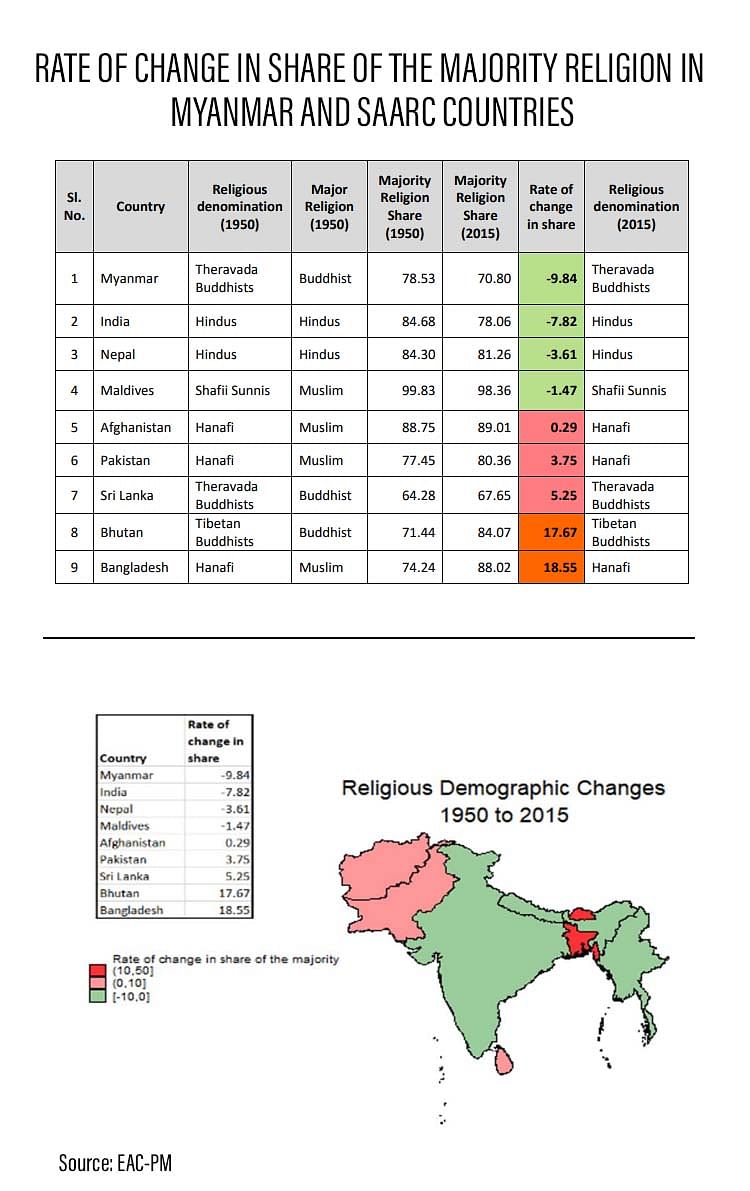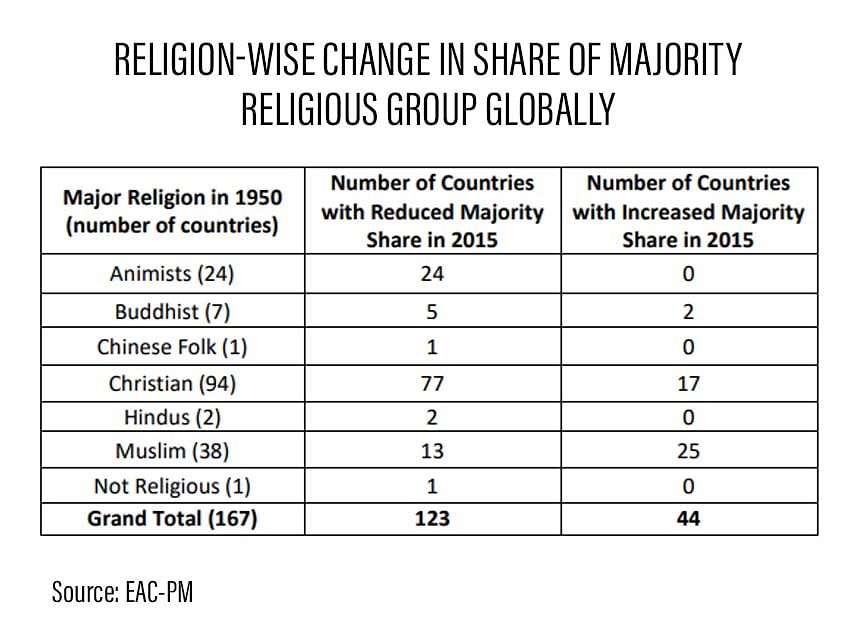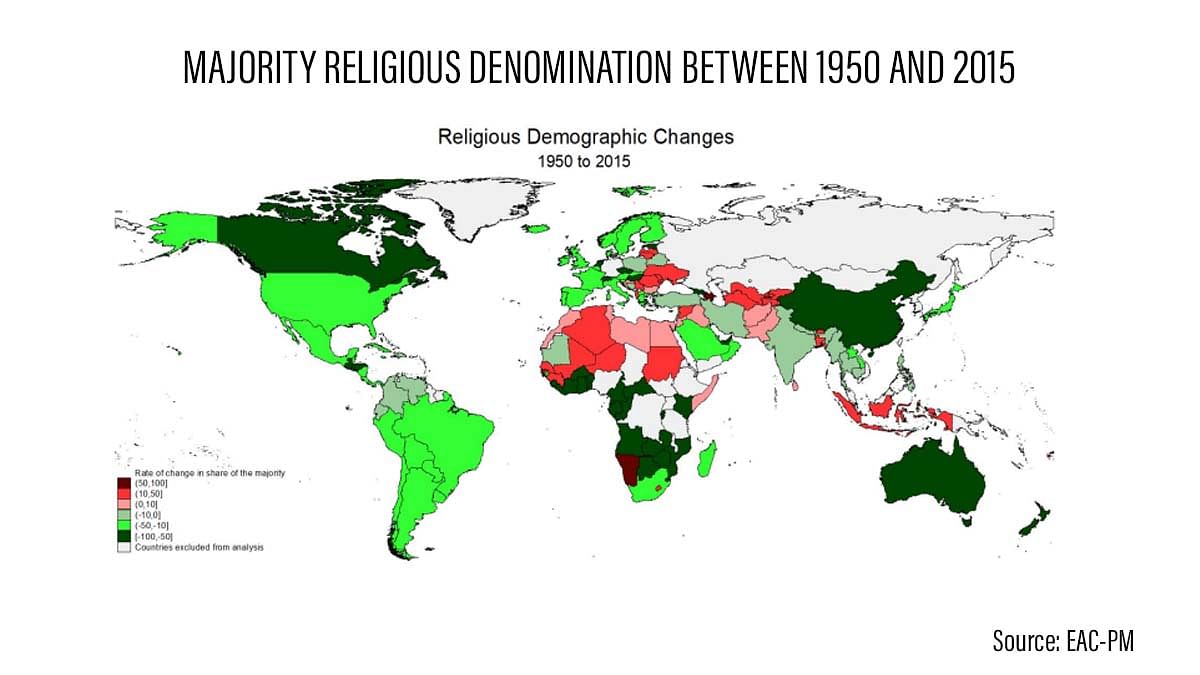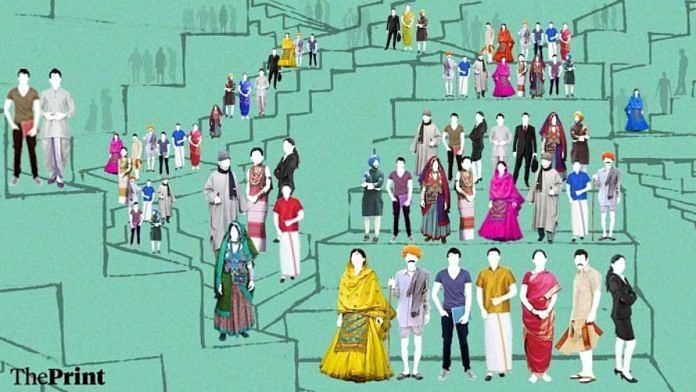New Delhi: The share of Hindu population in India decreased by 7.82 percent between 1950 and 2015, while that of the Muslims saw a 43.15 percent increase in the corresponding period, according to a working paper of the Economic Advisory Council to the Prime Minister (EAC-PM) released Tuesday.
Barring Parsis and Jains, the share of all other religious minorities in India saw saw a rise in their population share up to 6.58 percent in this period.
The share of the Christians rose from 2.24 percent in 1950 to 2.36 percent in 2015 (an increase of 5.38 percent), share of population went up from 1.24 percent to 1.85 percent (a 6.58 percent point rise) for the Sikhs as well as for the Buddhists whose population increased from 0.05 percent to 0.81 percent.
But the share of Jains in the population decreased from 0.45 to 0.36 percent and the Parsi population witnessed a “stark 85 percent decline”.
“In India the share of the majority Hindu population decreased by 7.82 percent between 1950 and 2015 (from 84.68 percent to 78.06 percent). The share of Muslim population in 1950 was 9.84 percent and increased to 14.09 percent in 2015 — a 43.15 percent increase in their share,” says the working paper, Share of Religious Minorities: A Cross-Country Analysis (1950-2015), authored by Shamika Ravi, Apurv Kumar Mishra and Abraham Jose.
The paper also throws light on the global trend in share of religious minorities and majorities in 167 countries over a period of 65 years.
In the Indian subcontinent, it says, all the Muslim majority countries witnessed an increase in the share of the majority religious denomination except Maldives where the share of the majority group (Shafi’i Sunnis) declined by 1.47 percent.
As opposed to the scenario in India, the share of the majority religious denomination has increased and minority populations have “shrunk alarmingly across countries like Bangladesh, Pakistan, Sri Lanka, Bhutan and Afghanistan”.
India, the paper says, provides a conducive environment to foster diversity in the society and the outcome of the “progressive policies and inclusive institutions” are reflected in the growing number of minority populations. It says that political changes are mere symptoms of deeper structural changes that are happening in societies due to a variety of transformations, of which demographic evolution is an important component.
“Contrary to the noise in several quarters, careful analysis of the data shows that minorities are not just protected but indeed thriving in India. This is particularly remarkable given the wider context within the South Asian neighborhood, where the share of the majority religious denomination has increased and minority populations have shrunk alarmingly across countries like Bangladesh, Pakistan, Sri Lanka, Bhutan and Afghanistan,” it says, referring to the situation in India.
Globally, the share of the majority population has decreased in 123 countries while it went up in 44 countries only, according to the paper.
The share of the majority religious denomination globally has gone down by approximately 22 percent. “On every major continent, more countries have seen a decline in the share of the majority religious denomination than increase,” it says.
Referring to the global trends on increase and decrease in the share of the majority religious population, the authors said, “Our hypothesis is that the change in the proportion of the minority population as a share of total population is a good proxy for the status of minorities in a country over time. A society which provides a congenial environment for the flourishing of minorities is more likely to witness an increase or stabilization in their numbers over a period of three generations.”
Also Read: Only half of India’s working-age population works, most still in agriculture, shows ILO report
Neighbourhood watch
Of the eight member countries of the South Asian Association for Regional Cooperation (SAARC) and Myanmar, the share of the majority religious denomination has decreased in four while it increased in five. The Indian subcontinent accounts for one-fifth of the global population.

In the 65-year period (1950 to 2015), there has been an increase in the share of Muslim population in Muslim majority countries, except Maldives, and many of the Hindu majority countries have witnessed a decline in majority religious population, the paper says.
“Among the five non-Muslim majority countries, Myanmar, India and Nepal saw a decline in the share of the majority religious denomination while Sri Lanka and Bhutan saw their share increase,” it says.
“Pakistan witnessed an increase of 3.75 percent in the share of the majority religious denomination (Hanafi Muslim) and a 10 percent increase in the share of total Muslim population despite the creation of Bangladesh in 1971,” it mentions.
“In Bangladesh, there was an 18 percent increase in the share of the majority religious group, which is the largest such increase in the Indian subcontinent.”
Similarly, the share of Muslim population rose from 99.4 percent to 99.7 percent in Afghanistan.
While India witnessed a decline of 7.8 percent in the share of Hindu population, other non-Muslim majority countries also saw a decline in the share of the majority religious denomination.
For instance, the share of Theravada Buddhist population declined by 10 percent —the steepest decline of the majority religious group in the region — during the study period in Myanmar.
The same holds true for Nepal where the majority Hindu population declined by 4 percent, and so did the share of Buddhist population by 3 percent. But “Muslim population increased by 2 percent,” the authors say.
“Only Sri Lanka and Bhutan among non-Muslim majority countries have witnessed an increase in the share of the majority religious denomination between 1950 and 2015”
“It is not surprising, therefore, that minority populations from across the neighborhood come to India during times of duress,” the paper says, referring to these trends.
In 2019, the Modi government brought the controversial Citizenship Amendment Act to facilitate citizenship to undocumented people belonging to Hindu, Sikh, Buddhist, Parsi, Christian and Jain communities from Pakistan, Bangladesh and Afghanistan. The rules for its implementation were notified by the Union home ministry last month.
Referring to the conducive environment to foster diversity in the society in India, the authors mention how persecuted populations from several countries have made India their home over the last six decades.
‘World has become more heterogeneous’

Globally, a majority of countries witness decline in majority religious groups. Of the 167 countries, the share of the majority religious group decreased in 123 while it increased in 44.
“Our analysis shows that the world has become more heterogeneous in the previous six decades,” the paper says.
In a post on ‘X’, formerly Twitter, Shamika Ravi said, “In 1950, Animism had a majority status in 24 countries (almost all of them in Africa). Animism did not just lose its share in the overall population but it is no longer a majority population in any of these 24 countries by 2015.”
The religion associated with the majority group in a country plays an important role in countries which have seen extreme changes, the authors note.

Analysing the data in these countries, the EAC-PM working paper says 20 countries that have seen the maximum increase in the share of the majority religious group are those where Christianity- or Islam-based denominations are the majority religious group.
“If we focus on the 20 countries that have seen the maximum decline in the share of the majority religious group, only 3 of them had Christianity or Islam based denominations as the majority religious group,” it said.
As per the analysis of majority religion in countries, 77 out of the 94 countries that reported being Christian majority have witnessed a decrease in the share of the majority religious group since 1950. “On the other hand, 25 out of the 38 countries that reported being Muslim majority in 1950 have seen an increase in share of the majority religious group while their share of the population has declined in only 13 countries,” it says.
(Edited by Tony Rai)
Also Read: India’s fertility rate plunged in last 70 yrs, population to shrink further by 2050 — Lancet study







aren’t jains and sikhs branch of hinduism?